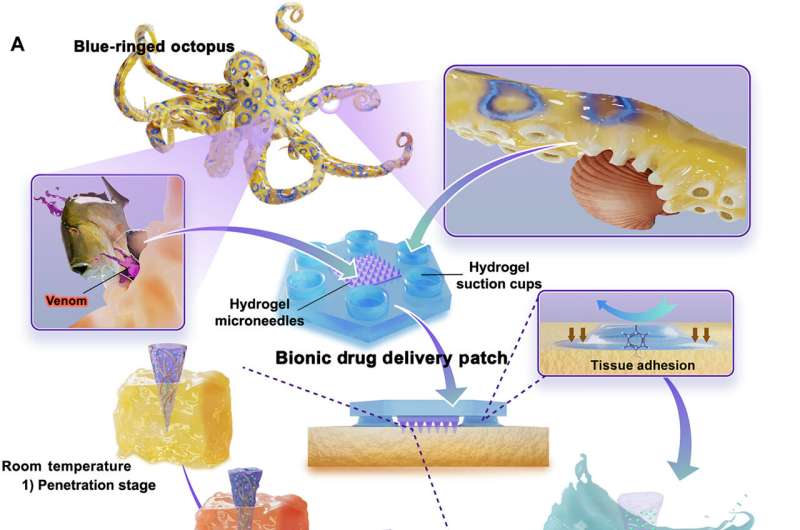June 27, 2023 report
This article has been reviewed according to Science X's editorial process and policies. Editors have highlighted the following attributes while ensuring the content's credibility:
fact-checked
peer-reviewed publication
trusted source
proofread
A microneedle patch for surface adhesion and injection drug delivery inspired by the blue-ringed octopus

A team of medical scientists and engineers affiliated with several institutions in China has developed a microneedle-based patch that adheres to surfaces to inject drugs, inspired by the mechanism used by the blue-ringed octopus to deliver venom. In their paper published in the journal Science Advances, the group describes their patch and its performance during testing.
Medical scientists often turn to nature as a guide. Last month, for example, a team at the Max Planck Institute for Intelligent Systems designed a medical robot based on the hard-shelled pangolin. In this new effort, the researchers in China looked to the blue-ringed octopus for inspiration.
The tiny (just 12- to 20-cm) blue-ringed octopus is well known for its deadly approach to capturing and eating prey—it has a bite that punctures the shells of crustaceans, allowing it to inject tetrodotoxin, a paralyzing agent. Noting its efficient approach, the team in China thought it might serve as inspiration for a new kind of microneedle-based patch.
Microneedle-based patches are currently used to deliver small doses of medicine to specific parts of the body over a period of time. But such patches tend to have adherence issues and problems associated with controlling the amount of medicine delivered. To overcome these issues, the research team designed a patch with hydrogel-based suction cups similar to those of the blue-ringed octopus.
They modified the needles to resemble the teeth of the octopus. They also used a combination of silk fibroin and F127 hydrogel to make the needles, which confer heat sensitivity, allowing for better control of drug release.
Testing the patch involved applying it to areas inside the mouths of animals inflamed with gum ulcers or superficial tumors. The research group found that the suction cups worked as hoped and that the shape of the teeth allowed for just the right amount of surface puncture for drug delivery. The heat-sensing microneedles began delivering medication within two hours of patch application.
Over the following two days, the patches delivered the desired amount of medication, maintaining a positive therapeutic effect. Longer term, the researchers found that their patches increased the healing speed of the ulcers and halted tumor growth.
More information: Zhou Zhu et al, Blue-ringed octopus-inspired microneedle patch for robust tissue surface adhesion and active injection drug delivery, Science Advances (2023). DOI: 10.1126/sciadv.adh2213
© 2023 Science X Network



















